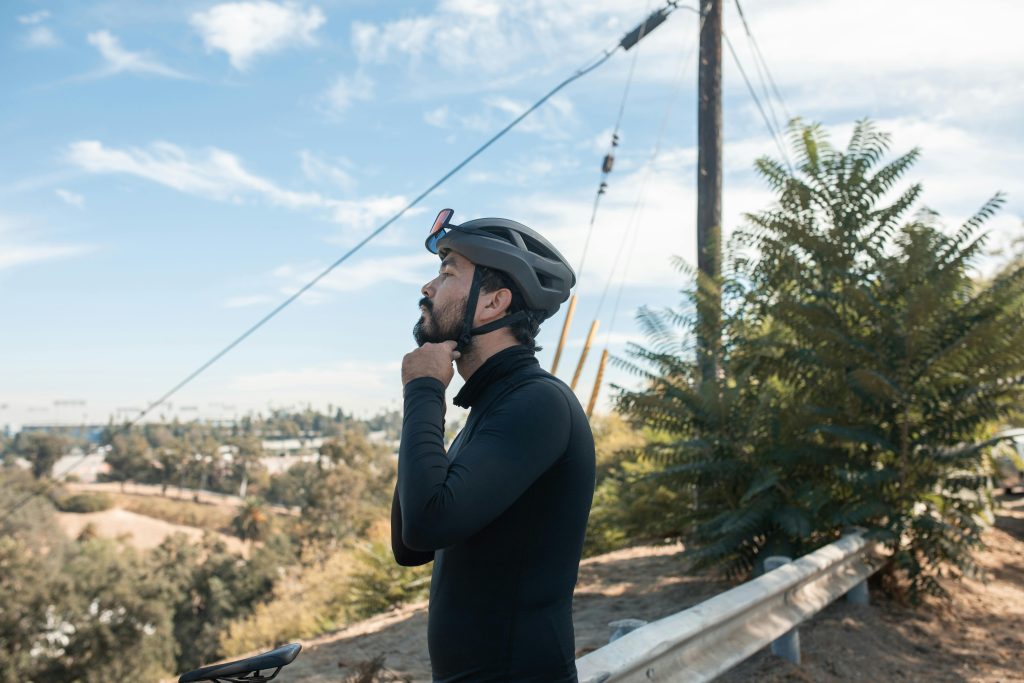When it comes to mountain biking, safety starts with your helmet! Whether you’re bombing down rugged trails or cruising on scenic routes, choosing the right mountain bike helmet is essential for protection, performance, and style. In 2025, the latest helmets boast advanced technologies, improved ventilation, and sleek designs. In this guide, we’ll reveal the top 10 best mountain bike helmets, packed with features to keep you safe and comfortable on every ride. Ready to find your perfect match? Let’s dive in!
Table of Contents
ToggleWhat to Look for in a Mountain Bike Helmet

When selecting a mountain bike helmet, it’s crucial to consider several key factors to ensure optimal safety and comfort on the trails:
Safety Certifications
Ensure the helmet meets recognized safety standards, such as CPSC, EN 1078, or ASTM F1952, which indicate the helmet’s ability to provide adequate protection in off-road conditions.
Fit and Sizing
A helmet that fits properly is crucial. To protect your forehead, it should rest level on your head, with the front edge no more than an inch over your eyebrows. The helmet should fit comfortably without being too tight. The helmet should stay in place if you put it on your head, leave it unlatched, and bend over at the waist to evaluate the fit.
Helmet Types
Select between half-shell (or open-face) helmets, which are appropriate for cross-country and trail riding, and full-face helmets, which provide complete protection and are perfect for downhill riding. Your riding style and the terrain you often ride on should guide your decision.
Ventilation
Having enough ventilation is essential for staying cool during long rides. To improve comfort on lengthy rides, look for helmets with several vents and internal channels that encourage air circulation.
Durability and materials
Choose helmets made of high-quality materials that are resilient to mountain biking’s demands. In-mould construction frequently offers a strong yet lightweight alternative, combining the impact-absorbing foam lining with the helmet’s outer shell.
By focusing on these aspects, you can select a mountain bike helmet that offers the protection you need while ensuring comfort and suitability for your specific riding adventures.
Top 10 Best Mountain Bike Helmets in 2025
When it comes to mountain biking, having the right helmet is crucial for both safety and performance. Here are ten best mountain bike helmets for 2025, each offering unique features to suit different riding styles and preferences:
Fox Speedframe Pro
This helmet is praised for its superior coverage, comfort, and ventilation. It has a 360-degree fit system for a snug and customised fit and an MIPS liner for improved rotational impact protection.
Troy Lee Designs A3
The A3 is well-known for its exceptional comfort, deep coverage, and efficient ventilation. It has a sweat management system and advanced safety features to keep riders dry and cool.
Smith Convoy MIPS
The Convoy MIPS is a fantastic deal for riders because it is an affordable alternative that combines the MIPS system and offers a comfortable fit with plenty of ventilation without sacrificing safety.
Lazer Coyote Kineticore
With Kineticore technology for enhanced impact absorption, this helmet provides an excellent balance between cost and safety. Because of its extensive coverage and easy-to-use fit system, it is appropriate for various trail situations.
POC Octal MIPS
The lightweight, well-ventilated Octal MIPS is perfect for cross-country cyclists. Its unibody shell design and MIPS technology offer superior protection, guaranteeing security without compromising functionality.
Troy Lee Designs Stage
The Stage is a top full-face helmet with complete protection and a lightweight design. It is made for aggressive trail and enduro riding and provides excellent comfort and ventilation for extended bike rides.
Smith Mainline MIPS
This multipurpose full-face helmet is commended for its outstanding ventilation and lightweight construction, which make it appropriate for downhill and trail riding. It also has a comfortable fit for prolonged use and the MIPS system.
Abus Moventor 2.0 MIPS
The lightweight, well-ventilated Moventor 2.0 MIPS helmet provides high protection and comfort. Its shell has a ponytail cutout for increased convenience and is appropriate for cross-country and trail riding.
Giro Merit Spherical
The Merit Spherical has a low profile, close-fitting comfort, and is loaded with safety technology. It is a dependable option for trail riders looking for advanced safety features because its layered construction offers superior impact protection.
Scott Argo Plus
The Argo Plus is a lightweight shell with great ventilation for cross-country loops and trail riding. It ensures complete coverage for a range of riding situations by providing prolonged protection on the sides and back of the head.
When choosing a mountain bike helmet, consider factors such as your riding style, the level of protection required, ventilation needs, and budget. Each of these helmets has been recognized for its quality and performance, ensuring you can find one that fits your specific needs for the 2025 riding season.
How to Choose the Right Helmet for Your Riding Style

Choosing the right mountain bike helmet is essential for both safety and comfort, and it largely depends on your riding style. Here’s how to make an informed decision:
1. Identify Your Riding Style

Cross-Country (XC)
If you enjoy long-distance rides on smoother trails, opt for a lightweight, well-ventilated helmet that offers sufficient protection without extra bulk.
Trail Riding
For varied terrains with moderate obstacles, choose a helmet that provides extended rear coverage and a sturdy visor to shield against sun and debris.
Enduro/All-Mountain
Engaging in aggressive downhill sections combined with uphill climbs requires a helmet that balances ventilation with increased protection, often featuring a removable chin guard for versatility.
Downhill (DH)
High-speed descents on technical trails necessitate a full-face helmet offering maximum coverage, including a chin bar, to protect against severe impacts.
2. Consider Safety Features
Impact Protection
Look for helmets equipped with advanced technologies like MIPS (Multi-directional Impact Protection System) or similar, designed to reduce rotational forces during angled impacts.
Certifications
Ensure the helmet meets relevant safety standards, such as CPSC, EN 1078, or ASTM F1952, indicating it has passed rigorous testing for impact resistance.
3. Evaluate Fit and Comfort

Proper Sizing
Measure your head circumference and consult the manufacturer’s sizing chart to select the appropriate size. A well-fitting helmet should sit level on your head, with minimal movement when adjusted correctly.
Adjustability
Opt for helmets with adjustable retention systems, such as dial-fit mechanisms, to fine-tune the fit for comfort and security.
Ventilation
Adequate airflow is crucial, especially for strenuous rides. Helmets with multiple vents and internal channeling help keep you cool by promoting air circulation.
4. Assess Additional Features
Visors
A visor can protect your eyes from sun glare, rain, and trail debris. Consider whether a fixed or adjustable visor suits your needs.
Weight
Lighter helmets reduce strain on your neck during long rides but should not compromise on safety features.
Compatibility
If you plan to use accessories like goggles or mount a camera, ensure the helmet design accommodates these additions.
By aligning your helmet choice with your specific riding style and preferences, you can enhance both your safety and enjoyment on the trails. Remember, the best helmet is one that fits well, meets safety standards, and suits the demands of your mountain biking adventures.
Maintenance Tips to Extend the Life of Your Helmet

Maintaining your mountain bike helmet is essential to ensure its longevity and, more importantly, your safety on the trails. Here are some practical tips to help you keep your helmet in top condition:
1. Regular Cleaning
Exterior
After each ride, gently wipe down the helmet’s outer shell with a soft cloth dampened with mild soap and water. This helps remove dirt and grime without damaging the helmet’s materials.
Interior Padding
Remove the internal pads and hand-wash them using mild soap and water. Rinse thoroughly and allow them to air dry completely before reinserting.
Straps
Clean the straps with soapy water, scrubbing gently to eliminate sweat and dirt buildup. Rinse and let them air dry.
2. Proper Storage
Avoid Direct Sunlight
Store your helmet in a cool, dry place away from direct sunlight, as prolonged exposure can degrade the materials over time.
Safe Placement
Keep the helmet away from sharp objects or heavy items that could cause dents or damage.
3. Inspection and Replacement
Regular Checks
Before each ride, inspect your helmet for any signs of damage, such as cracks, dents, or compromised straps. Even minor damage can reduce its effectiveness.
Post-Crash Replacement
If you’ve been involved in a crash where your helmet took an impact, it’s crucial to replace it immediately, even if there are no visible signs of damage. The internal structure may be compromised.
Scheduled Replacement
As a general guideline, consider replacing your helmet every 3 to 5 years, depending on usage and exposure to elements. Materials can degrade over time, reducing protective capabilities.
4. Avoid Chemical Cleaners
Mild Solutions Only
Refrain from using harsh chemicals, solvents, or abrasive cleaners, as they can weaken the helmet’s materials and compromise safety. Stick to mild soap and water for all cleaning purposes.
By following these maintenance practices, you can extend the life of your mountain bike helmet and ensure it continues to provide optimal protection during your rides. Remember, a well-maintained helmet is a key component of safe cycling.
FAQs About Mountain Bike Helmets

When it comes to mountain bike helmets, several common questions often arise. Let’s address some of these to help you make informed decisions:
1. What is MIPS Technology, and Do I Need It?
MIPS stands for Multi-directional Impact Protection System. It’s a safety feature designed to reduce rotational forces on the brain during angled impacts. This is achieved through a low-friction layer inside the helmet that allows slight movement upon impact, potentially decreasing the risk of certain brain injuries. While not mandatory, many riders prefer helmets with MIPS for the added peace of mind it offers.
2. How Often Should I Replace My Mountain Bike Helmet?
It’s generally recommended to replace your helmet every 3 to 5 years, even if it hasn’t been involved in a crash. Over time, materials can degrade due to exposure to elements like UV rays and sweat, potentially compromising the helmet’s protective capabilities. Additionally, if your helmet experiences a significant impact, it’s advisable to replace it immediately, as its structural integrity may be compromised.
3. Are More Expensive Helmets Safer?
Not necessarily. All helmets sold must meet specific safety standards, ensuring a baseline level of protection. Higher-priced helmets often offer additional features such as improved ventilation, lighter weight, enhanced comfort, or advanced technologies like MIPS. However, a well-fitting helmet that meets safety standards can provide adequate protection, regardless of price.
4. How Do I Ensure a Proper Helmet Fit?
Measure Your Head
Use a flexible tape measure to determine the circumference of your head, positioning it about an inch above your eyebrows.
Try Before You Buy
Whenever possible, try on helmets to assess comfort and fit. The helmet should sit level on your head, with the front edge one to two finger-widths above your eyebrows.
Adjust Straps and Retention System
Ensure the chin strap is snug but comfortable, forming a “V” shape under your ears. The retention system at the back should be tightened to prevent movement but not cause discomfort.
5. Can I Use a Road Bike Helmet for Mountain Biking?
While you can use a road bike helmet for mountain biking, it’s not ideal. Mountain bike helmets are specifically designed to offer more coverage, especially at the back of the head, and often include visors to protect against sun and debris. They also typically have better ventilation suited for the varying speeds and efforts in mountain biking.
6. What Maintenance Does My Helmet Require?
Cleaning
Regularly clean your helmet with mild soap and water. Avoid using harsh chemicals that can degrade the materials.
Inspection
Periodically check for any signs of damage, such as cracks or compromised straps.
Storage
Store your helmet in a cool, dry place away from direct sunlight to prevent material degradation.
By understanding these aspects, you can choose a mountain bike helmet that not only fits well but also aligns with your safety needs and riding style.
Conclusion
Your mountain bike adventures deserve the best gear, starting with a reliable helmet. In this guide, we’ve highlighted the best mountain bike helmets for 2025 and tips for selecting and maintaining your helmet. Safety is non-negotiable, but with the right helmet, you can hit the trails with confidence and style. Ready to make your pick? Start exploring the options today, and ride safe!


